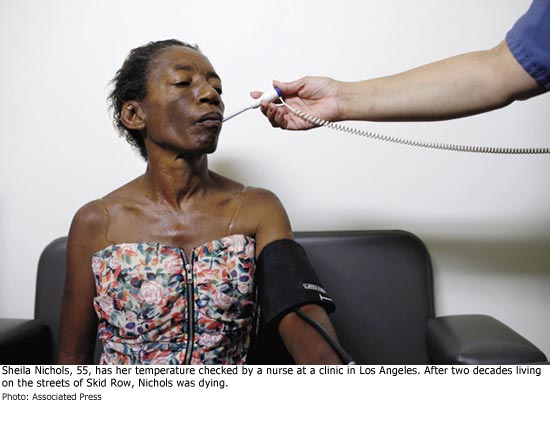Why Project 50 saves lives
August 2, 2010
If you want to solve homelessness in Los Angeles, you have to start on Skid Row.
I heard that observation voiced by a participant at a conference I convened in 2007. The words rang true to me then, as they do now. It is a simple declaration of a difficult fact: that Job One in fixing the national disgrace at the heart of downtown means trying some innovative tactics to begin alleviating some of the miseries endured by individuals on the street there.
The Los Angeles Times is now in the midst of a four-part series chronicling Project 50, the initiative that grew out of that conference. As the first story points out—and as the newspaper suggests in promoting the upcoming installments—it has been a difficult journey, with many hard-won successes and some disappointments along the way.
Project 50 is one of the most rewarding public policy initiatives I have ever sponsored. Its foundations were established at that 2007 conference, sponsored by the Rockefeller Foundation. We brought people to Los Angeles from across the country—people who had successfully turned around homelessness in their own cities and counties. Before meeting with our policy makers and civil servants, these out-of-town participants toured Skid Row, and every one came away recommending that we start there.
Roseanne Haggerty, who runs Common Ground, a New York non-profit that deals with homelessness, suggested we launch a pilot that would identify the most vulnerable homeless people on Skid Row—those most likely to die on our streets. Then, we’d find them a place to live and give them the services they needed. In the language of homeless advocates, this is called permanent supportive housing.
Since we would be going after the most troubled people—the hardest cases who for years had resisted every program to come along—we needed to be innovative to reach them. So we broke with conventional practice and did not make it a precondition that participants accept services in order to get a roof over their heads.
But once we got them housed, our county and affiliated non-profit agencies had one, unified goal: to surround them with the health care, mental health care and substance abuse services they required.
It was a relentless mission. Once these clients moved in, our people were on them like a wet blanket, pushing to get them the help they needed.
And here’s the striking part: every single participant ended up agreeing to accept at least one kind of treatment.
What has evolved in the last 2 ½ years has been nothing short of remarkable. Project 50 has actually housed 68 homeless persons, most of whom had health, mental health and substance abuse issues. Many had been homeless on the streets of Los Angeles for more than 10 years; one had been homeless for 37 years. These were the most challenging of the challenged homeless persons in our county. And because of Project 50, we were finally able to break through—not to all, but to a very substantial majority.
Since 2008, nearly 84% of those we housed remain housed, a statistic which has left in tatters the myth that we can’t get chronically homeless persons into housing. And 100% of the clients have received one or more of the health care, mental health or substance abuse treatments they desperately needed.
A collateral benefit is that this pilot has been a money saver as well—a point recognized by the Economic Roundtable and others. The cost of running this program is more than made up by the savings realized by the relative stability that has been restored to our clients. Before Project 50, most of its participants landed in jail or in hospital emergency rooms multiple times each year. Since being in the program, most have avoided incarceration or hospitalization at a considerable financial savings to taxpayers.
And when progress is measured in human lives saved—lives that almost certainly would have been lost on the streets without Project 50—that represents a success well worth celebrating and replicating.
Project 50 has rapidly expanded beyond Skid Row to other parts of the county. Nearly 400 permanent supportive housing units are in the pipeline in West L.A., Van Nuys, Venice, Santa Monica, Hollywood, West Hollywood and Long Beach. Other communities have expressed serious interest as well.
Los Angeles has often been called the homeless capital of the nation, and one could hardly argue with that moniker. It can be very daunting to try to address the housing and service needs of well over 10,000 chronically homeless people in our county. That’s why dealing with them 50 or 500 individuals at a time made so much sense to me. Project 50 established the template. The same methodology that was applied to housing 50 chronically homeless can be applied to 500 or 5,000.
Thanks to this project, and its courageous and dedicated county employees and their non-profit partners, we are on our way.
Posted 8/02/10
L.A. Times columnist Steve Lopez has weighed in on Project 50, praising its hard-won successes for the chronically homeless on Skid Row as “no small triumph.” Read his column here. And our article on the Project 50 debate that cropped up at last week’s Board of Supervisors meeting is here.













 405 bridge work causes a stink
405 bridge work causes a stink





